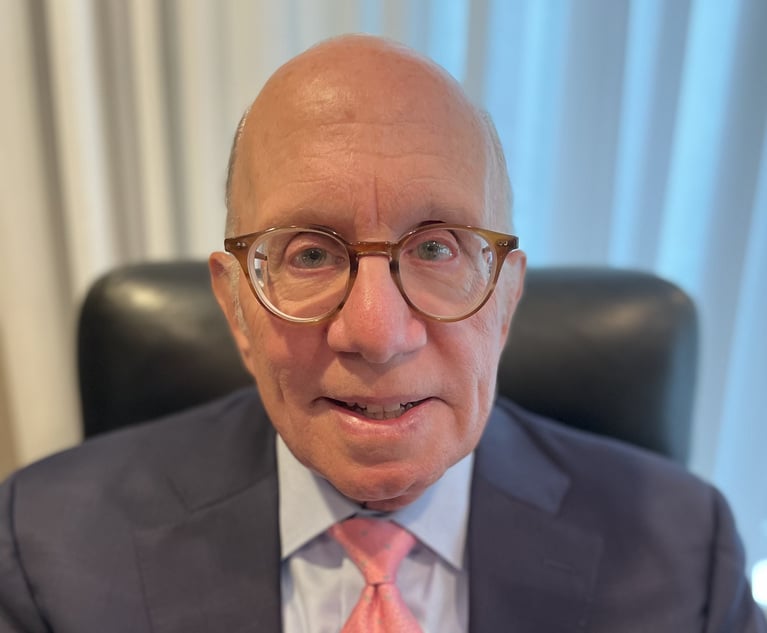Reading Back Expert Testimony: Is It Time To Go to the Videotape?
The jury should have the option of seeing the actual testimony as they had it during the trial.
February 28, 2020 at 11:30 AM
8 minute read
 All trial lawyers and judges—civil and criminal—are familiar with the (dreaded?) readback requests of the jury during deliberations. As with many aspects of the trial, the court has considerable discretion in responding to such requests. The vast majority of case law on the subject stems from criminal cases (CPL 310.30), essentially holding that the court, in responding to a request from the jurors for testimony to be read to them, may give such information as the court deems proper. Case law, again the vast majority from the criminal side, also gives the court fairly wide berth in managing the process. The language in U.S. v. Damsky, 740 F.2d 134 (2d Cir.) is representative: "… in making the determination, the trial court, in its discretion, may take into account factors such as whether reading certain testimony back will unduly call attention to it; whether giving the readback will unduly delay the proceeding, and the difficulty in giving a readback." Id. at 138.
All trial lawyers and judges—civil and criminal—are familiar with the (dreaded?) readback requests of the jury during deliberations. As with many aspects of the trial, the court has considerable discretion in responding to such requests. The vast majority of case law on the subject stems from criminal cases (CPL 310.30), essentially holding that the court, in responding to a request from the jurors for testimony to be read to them, may give such information as the court deems proper. Case law, again the vast majority from the criminal side, also gives the court fairly wide berth in managing the process. The language in U.S. v. Damsky, 740 F.2d 134 (2d Cir.) is representative: "… in making the determination, the trial court, in its discretion, may take into account factors such as whether reading certain testimony back will unduly call attention to it; whether giving the readback will unduly delay the proceeding, and the difficulty in giving a readback." Id. at 138.
Blow ups of photographs, pages of medical records, anatomical drawings and the like are regularly put into evidence in our trials. But as a judge who presides over a fair amount of medical malpractice cases, it has become apparent to me that as the quality and quantity of demonstrative evidence has increased greatly over the last decade or so, there are serious questions that the trial bench and bar should be considering over how to best handle these items when they are the subject of a jury readback request. A recent trial that I presided over highlights a particular potential issue of concern to me—how to handle the readback request of expert(s) who have each spent 20 minutes at a video screen explaining their interpretation of an MRI at issue in the case.
This case involved a tri-level anterior cervical discectomy fusion with hardware. The complaint had two aspects: lack of informed consent and a deviation in the type of attempted corrective surgery done. The testifying experts were a neuroradiologist, neurosurgeon, orthopedic spine surgeon and neurologist. The radiologist and surgeons spent a considerable amount of time at a large video monitor wheeled in front of the jury answering specific questions about pre-operative, intraoperative and post-surgical MRIs, a not uncommon experience for those who regularly engage in this type of practice. The MRI studies, on CD discs, were appropriately placed into evidence and both the attorneys and I regularly implored the witnesses, as best they could, to identify for the record the image that they were referring to while they testified. Each view typically had six images—three over three—and then an image was blown up to the whole screen and then reduced again to the original format.
The following is an edited excerpt from some of that testimony of the plaintiff's radiologist:
This is the NRAD Lakeville Imaging. It's a picture of 7 out of 13 sag, S-A-G, T1. Q. Do you see that at the bottom?
A. Yes
Q. So what does this mean? What does this show to you?
A. … so these I'm pointing at are the vertebral bodies. There are 7 vertebral bodies in the cervical spine. C1 doesn't have a body like this. It has a ring. That's C1, C2,3,4,5,6 and 7. So we see the bone. This structure here is the spinal cord. And that carries all the nerve information that allows you to feel and move.
Now in between the vertebrae are the discs. We have the vertebral discs.
They're seen. They're the color on T1. For example, this doesn't look so good compared to the other ones and then there's other tissues such as veins. These structures here represent epidural veins.
So now this is the back of those vertebrae. Each one of them has a ring, a central canal, and there are posterior elements like spinous processes that we are seeing here, and then what they lamina. I think it will show it on the axial slice will be easier.
So we do look at different sequences to learn about the tissue we're looking at. So this is a T1 weighted sagittal sequence. We do a T2 sagittal sequence. We do a variety of axial sequences which would be this way going through the disc like this. Sagittal, as I said, is this way.
Several days later, the defendant's neuroradiologist testified. In this portion of his testimony concerning the same exhibit. He was asked to orient the jury and identify what it was. He testified as follows:
A. This is a T2 weighted sagittal MRI looking from the side. This is an axial like we cut it and look down upon them of the same series of the same year and what the green line means is I look down the sagittal here, it is right down the middle here. When I cut like this, it is going to go, scroll down so you could see each level accordingly …
Q. Okay. Please identify for the jurors, we have had this before I guess it is—the various anatomical structure we are looking at here.
A. On this right hand image the sagittal, these are the vertebral bodies, these square shaped bones. The disc space sits just underneath them. Another vertebral body, a disc, a vertebral body and a disc. Behind them this would be the front of the patient, the brain is up here, the behind would be down here and the back is over here. The white stripes here are the fluid surrounding the spinal cord. This is the spinal cord, there is fluid behind the spinal cord and you have the soft tissues behind the spine, the back of your neck. (indicating)
Consider that each of these witnesses testified for dozens of pages and were followed by several other experts who also utilized the MRIs during their testimony.
Luckily, there were no requests for expert readbacks during the two days of deliberation before the case settled. But it was a concern to me that had there been, the testimony would likely be impossible for the jury to follow because while they could have the appropriate exhibit placed on the screen during the reading, they would never be able to match up the testimony to the appropriate image. Bear in mind that some of the testimony highlighted a single large image and others showed six or nine images on the screen, each in its own "box."
If the jury had requested some part of any of the MRI testimony readback, I think I would have had three options, none of them ideal. Assuming that the jury would not think to ask to see the MRI while the testimony was read, we could simply comply with the request and have it read. If they requested the images as well, the next option would attempt to have the attorneys stipulate an agreement as to what they should see during the readback, without any pointing or further explanation, probably a difficult thing to achieve via a stipulation. The next option would be to simply deny the request regardless of what the attorneys' positions were, informing the jury that without the live witness explaining what he was pointing to during the readback would be of no value to them and they should continue to deliberate. As I said, none of these are ideal.
What would be ideal? I think that the jury should have the option of seeing the actual testimony as they had it during the trial. And the only way to achieve that would have been to have videotaped the testimony of the experts. The video should be made from the same view the jury had during the trial, probably requiring that a phone be set up on a small tripod or stand on the jury rail or back row of the jury box while the testimony is occurring. Then, if a readback is required, the jury would have a "viewback" of the expert testimony.
I know the presence of a phone or video camera may take getting used to, but in fairness to all parties, if I had to choose between this process and denying the readback altogether, I think the former is favorable than the latter. As digital modeling and technically-advanced aides to the jury become more sophisticated every year, we should be able to figure this problem out. Otherwise I predict that trial judges will be put in the unenviable position of a meaningless readback, no readback or a mistrial. We can do better.
Arthur M. Diamond is a justice of the Supreme Court, Nassau County.
This content has been archived. It is available through our partners, LexisNexis® and Bloomberg Law.
To view this content, please continue to their sites.
Not a Lexis Subscriber?
Subscribe Now
Not a Bloomberg Law Subscriber?
Subscribe Now
NOT FOR REPRINT
© 2024 ALM Global, LLC, All Rights Reserved. Request academic re-use from www.copyright.com. All other uses, submit a request to [email protected]. For more information visit Asset & Logo Licensing.
You Might Like
View All
Patent Trolls Come Under Increasing Fire in Federal Courts

Why Is It Becoming More Difficult for Businesses to Mandate Arbitration of Employment Disputes?
6 minute readTrending Stories
- 1Friday Newspaper
- 2Judge Denies Sean Combs Third Bail Bid, Citing Community Safety
- 3Republican FTC Commissioner: 'The Time for Rulemaking by the Biden-Harris FTC Is Over'
- 4NY Appellate Panel Cites Student's Disciplinary History While Sending Negligence Claim Against School District to Trial
- 5A Meta DIG and Its Nvidia Implications
Who Got The Work
Michael G. Bongiorno, Andrew Scott Dulberg and Elizabeth E. Driscoll from Wilmer Cutler Pickering Hale and Dorr have stepped in to represent Symbotic Inc., an A.I.-enabled technology platform that focuses on increasing supply chain efficiency, and other defendants in a pending shareholder derivative lawsuit. The case, filed Oct. 2 in Massachusetts District Court by the Brown Law Firm on behalf of Stephen Austen, accuses certain officers and directors of misleading investors in regard to Symbotic's potential for margin growth by failing to disclose that the company was not equipped to timely deploy its systems or manage expenses through project delays. The case, assigned to U.S. District Judge Nathaniel M. Gorton, is 1:24-cv-12522, Austen v. Cohen et al.
Who Got The Work
Edmund Polubinski and Marie Killmond of Davis Polk & Wardwell have entered appearances for data platform software development company MongoDB and other defendants in a pending shareholder derivative lawsuit. The action, filed Oct. 7 in New York Southern District Court by the Brown Law Firm, accuses the company's directors and/or officers of falsely expressing confidence in the company’s restructuring of its sales incentive plan and downplaying the severity of decreases in its upfront commitments. The case is 1:24-cv-07594, Roy v. Ittycheria et al.
Who Got The Work
Amy O. Bruchs and Kurt F. Ellison of Michael Best & Friedrich have entered appearances for Epic Systems Corp. in a pending employment discrimination lawsuit. The suit was filed Sept. 7 in Wisconsin Western District Court by Levine Eisberner LLC and Siri & Glimstad on behalf of a project manager who claims that he was wrongfully terminated after applying for a religious exemption to the defendant's COVID-19 vaccine mandate. The case, assigned to U.S. Magistrate Judge Anita Marie Boor, is 3:24-cv-00630, Secker, Nathan v. Epic Systems Corporation.
Who Got The Work
David X. Sullivan, Thomas J. Finn and Gregory A. Hall from McCarter & English have entered appearances for Sunrun Installation Services in a pending civil rights lawsuit. The complaint was filed Sept. 4 in Connecticut District Court by attorney Robert M. Berke on behalf of former employee George Edward Steins, who was arrested and charged with employing an unregistered home improvement salesperson. The complaint alleges that had Sunrun informed the Connecticut Department of Consumer Protection that the plaintiff's employment had ended in 2017 and that he no longer held Sunrun's home improvement contractor license, he would not have been hit with charges, which were dismissed in May 2024. The case, assigned to U.S. District Judge Jeffrey A. Meyer, is 3:24-cv-01423, Steins v. Sunrun, Inc. et al.
Who Got The Work
Greenberg Traurig shareholder Joshua L. Raskin has entered an appearance for boohoo.com UK Ltd. in a pending patent infringement lawsuit. The suit, filed Sept. 3 in Texas Eastern District Court by Rozier Hardt McDonough on behalf of Alto Dynamics, asserts five patents related to an online shopping platform. The case, assigned to U.S. District Judge Rodney Gilstrap, is 2:24-cv-00719, Alto Dynamics, LLC v. boohoo.com UK Limited.
Featured Firms
Law Offices of Gary Martin Hays & Associates, P.C.
(470) 294-1674
Law Offices of Mark E. Salomone
(857) 444-6468
Smith & Hassler
(713) 739-1250








